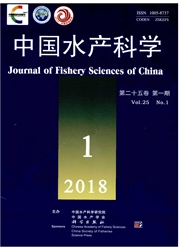

 中文摘要:
中文摘要:
采用逆转录聚合酶链反应(RT-PCR)和c DNA末端快速扩增(RACE)技术,依据锯缘青蟹(Scylla serrata)几丁质酶基因的保守区设计引物,克隆了中华绒螯蟹(Eriocheir sinensis)几丁质酶基因(HXchit)全长,并通过荧光定量PCR(q RT-PCR)技术研究了HXchit在中华绒螯蟹的同一蜕皮阶段不同组织、不同蜕皮阶段主要几个组织的表达情况。结果显示,HXchit基因c DNA全长2 042 bp(Gen Bank accession no.KJ513466),包括5′非编码区(5′UTR)35 bp,3′非编码区(3′UTR)537 bp,开放阅读框(ORF)1 470 bp,编码490个氨基酸,预测分子量和理论等电点分别为53.44 k D和4.41。经BLASTN和BLASTX分析,HXchit基因的氨基酸序列与锯缘青蟹几丁质酶的氨基酸序列同源性最高,相似性为75%;经聚类分析,HXchit氨基酸序列与锯缘青蟹几丁质酶聚为一支。q RT-PCR结果显示,HXchit在所检测的组织中均有表达,各组织的表达量依次为肝胰腺〉表皮〉肌肉〉胃〉鳃〉胸神经节〉肠〉心脏〉脑神经节。对不同蜕皮周期的中华绒螯蟹分析显示,肝胰腺中HXchit表达水平在D期最高,并与E期、AB期及C期呈显著性差异(P〈0.05);表皮中HXchit在E期、AB期、C期和D期的表达水平呈逐渐升高的趋势,D期表达量达到最高且与E期、AB期、C期呈显著性差异(P〈0.05);肌肉中HXchit表达量在C期最高,但各蜕皮时期的表达量之间差异不显著(P〉0.05)。结果表明HXchit是一种在中华绒螯蟹肝胰腺中大量表达的酸性几丁质酶,推测其在蜕皮周期中对几丁质类食物的消化或内源性几丁质的降解起到了重要作用,本研究旨在为进一步探索几丁质酶的准确生理功能和调控机制奠定分子基础。
 英文摘要:
英文摘要:
Chitinase enzymes play a critical role in molting in crustaceans. Eriocheir sinensis undergoes several molts in its lifetime. We cloned the chitinase gene from E. sinensis using reverse transcriptase polymerase chain reaction and rapid-amplification of c DNA ends. Primers were designed based on the conserved sequence of chitinase from Scylla serrata. The full-length c DNA sequence of HXchit was 2 042 bp, including a 1 470 bp ORF(encoded 490 amino acid residues), a 35 bp 5′-UTR, and a 537 bp 3′-UTR. The calculated molecular weight and isoelectric point were 53.44 k D and 4.41, respectively. A homology analysis using BLASTn and BLASTx revealed that the HXchit gene of E. sinensis shared 75% identity with S. serrata. The phylogenetic tree of the chitinase gene generated by the Neighbor Joining method suggested that HXchit is clustered closely with that of S. serrata. The expression of HXchit-m RNA in different tissues and molting stages of E. sinensis was analyzed by real-time fluorescent quantitative PCR. HXchit-m RNA was expressed in all tissues examined and levels were highest in the hepatopancreas, with only low levels of expression in the muscle, stomach, gill, and cuticle, and trace levels of expression in the heart, intestine, thoracic ganglion, and brain ganglion. HXchit-m RNA expression in the hepatopancreas peaked during the D stage, and there was a significant difference(P〈0.05) in expression in the hepatopancreas between stages E, AB, and C. In the cuticle, the level of HXchit-m RNA expression increased gradually during the molting cycle, and was significantly higher during D stage than during all other stages(P〈0.05). Expression levels were relatively low in the stomach throughout the molt cycle. In muscle, HXchit-m RNA expression was highest during C stage, but there was no difference in the level of expression between the different molting stages(P〉0.05). Our results demonstrated that HXchit is a form of acid chitinase and is expressed abundantly in the hepatopancreas. HXchit
 同期刊论文项目
同期刊论文项目
 同项目期刊论文
同项目期刊论文
 期刊信息
期刊信息
